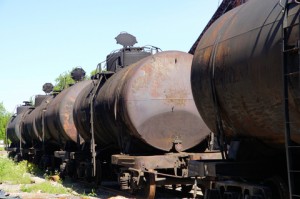A train carrying Bakken crude that derailed earlier this month, was following North Dakota regulations.
Related: Crude by Rail Under Attack
On June 3rd, 11 cars of a Union Pacific train jumped the tracks near the small town of Mosier Oregon, sparking a fire and releasing oil near the Columbia River. Federal Railroad Administration officials are now saying that the oil on the train met North Dakota’s oil conditioning standards.
The North Dakota Department of Mineral Resources requires that companies remove the most volatile gases from their crude before transport, limiting the vapor pressure to 13.7 pounds per square inch. The oil on the most recent crash recent had a vapor pressure of 9.2 pounds psi.
Bakken oil is produced at a high quality that makes it easier to refine into commercial products and makes it easier to ignite. Light oil production growth in the Bakken isn’t something the industry has never handled before, but the Bakken boom is bigger than anyone expected. As a result of lack of pipelines and additional infrastructure, nearly 70% of all Bakken crude is transported by rail.
Reports have crude by rail transport up 1700% over the last five years and accidents at a near-tenfold rise since 2008. With oil production currently at all time highs many fear that the number of accidents will increase and add to recent incidents:
In 2015, the NTSB outlined its findings from their study of recent train derailment accidents and concluded that the current fleet of DOT-111 tank cars rupture too quickly and result in spillage and ignition. The agency also found that performance of the industry’s enhanced CPC-1232 rail car is unsatisfactory. Based on their study, the NTSB gave the following recommendations that would require:
- All new and existing tank cars used to transport all Class 3 flammable liquids be equipped with thermal protection systems that meet or exceed the thermal performance standards
- All new and existing tank cars used to transport all Class 3 flammable liquids be equipped with appropriately sized pressure relief devices that allow the release of pressure under fire conditions and that minimizes the likelihood of energetic thermal ruptures
- An aggressive, intermediate progress milestone schedule, such as a 20 percent yearly completion metric over a 5-year implementation period, for the replacement or retrofitting of legacy DOT-111 and CPC-1232 tank cars to appropriate tank car performance standards
- Establishment of a publicly available reporting mechanism that reports at least annually

